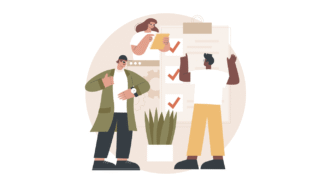LESSON OVERVIEW
In this lesson, students learn about furniture retailer IKEA and discuss its business model. Then, they come up with their own business idea for a shop.
C1 / Advanced60 minStandard LessonPremium Plan
VOCABULARY & VIDEO
The lesson starts with a warm-up activity in which students look at two photos, one of a person assembling a chair at home, and one of a warehouse store, and decide how the two can be connected. Then, students learn some vocabulary useful for understanding the video. They are given six pairs of words and phrases (e.g. retailer / wholesaler, designated road / winding road) and have to decide what the difference between each two is. After that, they look back at the two photos and discuss which of the things listed in the task can be found in them (e.g. flat-packed furniture, maze). In the next exercise, students read six sentences and complete each gap with one word (e.g. layout, resembles, frustratingly). They are provided with the context, definitions, and first letters of each word. At this point students move on to the video activities. They watch the first part of the video and decide which of the ideas from the previous exercise were true, false, or not mentioned at all. While they watch the video for the second time, they need to take notes on some ideas connected with IKEA (e.g. the IKEA effect, democratic design).
DISCUSSION & IDEAS
In this part of the lesson, students have plenty of opportunities to talk. First, they discuss what they learned from the video, share their opinions on IKEA business model, and talk in detail about ideas such as a $1 light bulb or democratic design. They also talk about their own approach to furniture assembly as potential IKEA customers. After that, students work in pairs or small groups and prepare their own business model. They choose a type of shop (e.g. confectionery shop, pet furniture shop) and use a list of questions to guide them. The questions refer to design, manufacturing and distribution, as well as the potential use of the IKEA effect or the idea of democratic design. Finally, in the last part of the lesson students revise the vocabulary learnt during the class. They have to complete seven sentences with correct forms of the words studied in the lesson (e.g. wind-winding, convention-unconventional). This task can also be used as homework and it’s only included in the Teacher’s Version of the worksheet.
WORKSHEETS
Subscribe to unlock these and many other Standalone lesson with the Premium plan
Subscribe











Great stuff! Thanks a bunch.
filipe
Thanks, Filipe!
This is a great class my students really enjoyed it! Maybe there could be one on Costco next? 🙂
Thanks!
It’s really good to hear your students liked the lesson.
And thanks for the Costco idea, we will consider it.
It’s a nice lesson, but to be honest, not so new. I mean, companies like IKEA have been on the market for many years. It could be good for people who do not have a lot of knowledge about business, but my business students are well aware of them. I would like them to learn about some much more modern business models, such as subscription model, or models when the final user doesn’t actually pay a dime.
Hi Betty! Thanks for the ideas. We might create a lesson around them 🙂
Excellent lesson! Thank you.
Thank you, that’s great to hear 🙂